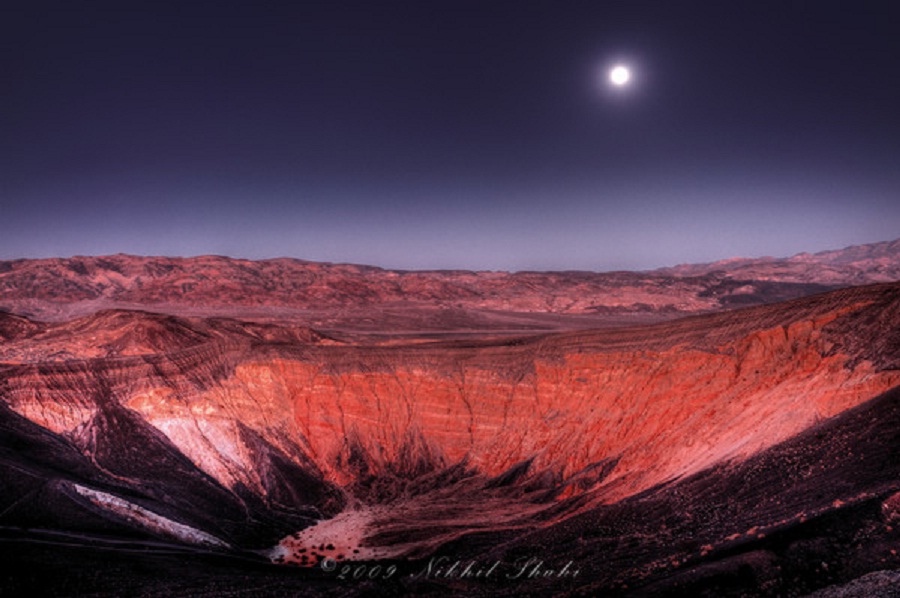 | в районе кратера гидравлического взрыва Ubehebe в Долине Смерти |
|
|
|
|
|
приуроченность к крупным закартированным разломам земной коры
The Ubehebe Craters are a small field of some 13 phreatic explosion craters, the largest of which is Ubehebe Crater itself. These craters formed when rising basaltic magma encountered groundwater and flashed to steam. The most recent research suggests that Ubehebe Crater formed only 300 years ago
Summary of Holocene eruptive activity
http://vulcan.wr.usgs.gov/Volcanoes/California/Hazards/Bulletin1847/table_holocene_volcanoes.html
Summary of Holocene eruptive activity
http://vulcan.wr.usgs.gov/Volcanoes/California/Hazards/Bulletin1847/table_holocene_volcanoes.html
C http://en.wikipedia.org/wiki/Ubehebe_Crater -
Ubehebe Crater, маар, 752 (м). Последнее извержение 4050 год до н.э.
Ubehebe Crater is a large volcanic crater of the Ubehebe Craters volcanic field in the northern half of Death Valley, located at the north tip of the Cottonwood Mountains. The crater is one kilometer wide and 150 to 237 m deep. The age of the crater – 2-7 KA. In 2012, new evidence suggested that the crater may be as young as 800 years old. The crater was formed when magma migrated close to the surface and the heat of the magma flashed groundwater into steam, throwing large quantities of pulverized old rock and new magma across the stony alluvial fan draped across the valley floor. The magma rose through a fault that lies along the western base of Tin Mountain. Movement on this fault was responsible for uplift of the entire Cottonwood Mountains range.
The resulting large steam explosions are called a hydrovolcanic or phreatic eruption by geologists and the pits created are known as maars. Ubehebe was the last and largest in series of similar eruptions in the immediate area (its eruption exceeded the tensile strength of the bedrock by 10 times).
Earlier eruptions created a group of much shallower maars to the south and another to the west. Little Hebe is a spatter cone that grew in the middle of one of the largest maars in the south group. The only significant deposit of lava in the volcanic field is contained in Little Hebe.
All of the maar-forming eruptions sent out fallout debris that mantled a broad area around the volcanic field (dozens of steam explosions issued from Ubehebe alone). The resulting light to dark gray cinder deposits consist of finely fragmented volcanic rock mixed with pulverized bedrock and are thickest immediately next to Ubehebe (25 m). Rills and gullies that were 4.5 - 6 m deep dissected the area prior to the eruptions and were buried by the fallout.
Erosion has since re-excavated these features, exposing layers of cinder that still overlay adjacent ridges.
A type of pyroclastic flow called a base surge was sent out of Ubehebe by one of the explosions. It started after a large column of debris were thrown skyward began to collapse. A doughnut-shaped cloud of hot ash and gas (the base surge) sped 100 to 200 mph (160 to 320 km/h) from the base of the column while staying close to the ground, plastering the Ubehebe-facing side of all objects in the area. Several mafic phreatomagmatic tephra eruptions in Holocene time.
Phreatomagmatic eruptions associated with base surges and small volumes of tephra.
Miocene-aged mostly reddish orange-colored conglomerate makes up the exposed bedrock in Ubehebe''s walls. These sediments were deposited by streams and contain limestone, mudstone, quartzite and volcanic cobbles that are up to 20 cm in diameter. There is also a difference in color between these seabed sediments: On the left these sediments are yellowish in hue while on the right they are orange. The reason is due to a fault that separates the two different sedimentary units; over time at least 120 m of vertical displacement along this fault has resulted in the abutment of these two different sedimentary units. Fallout debris dip 9 m over the fault scarp on the pre-eruption surface but have not been offset by it.
Within Ubehebe small alluvial fans have been built on the crater wall along with talus slumps from debris flows.
White silt covers the crater bottom of Ubehebe and some surrounding craters.




